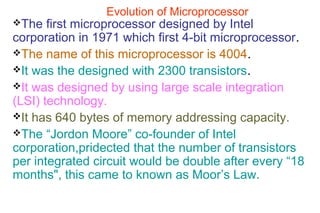The document discusses the evolution of microprocessors from 1971 to present. It begins with Intel releasing the first microprocessor, the 4-bit 4004, in 1971. The document then outlines the progression from 4-bit to 8-bit to 16-bit and finally 32-bit and 64-bit microprocessors. It provides details on the features of early microprocessors like the 8008, 8080, 8085 and later models like the 8086, 80286, 80386 and Pentium. The number of transistors integrated onto a single chip doubled every 18 months, as predicted by Moore's Law.






















![8085 Microprocessor Architecture or Block diagram of 8085
• 3.Register Organisation:Resgisters are used by
microprocessor for temporary storage of data & instructions.
• These registers are known internal memory of M.processor.
• The 8085 has following registers :-
• 1] One 8-bit accumulator (ACC) or Reg. A
• 2] Six 8-bit general purpose registers these are B,C,D,E,H,L.
• 3] One 16-bit stack pointer (SP)
• 4] One 16-bit program counter (PC)
• 5] Instruction register
• 6.Temporary Register](https://image.slidesharecdn.com/47467975-8085-microprocessor-170830040649/85/8085-microprocessor-23-320.jpg)
![8085 Microprocessor Architecture or Block diagram of 8085
• 1] One 8-bit accumulator (ACC) or Reg. A :-
• Accumulator is 8-bit registers.
• It is also known as Reg.A.
• It is used to hold one of the operand (data) of an
arithmetic & logical operation.
• The another operand (Data) for arithmetic & logical
operations may stored in memory or one of the
register.
• It is used as input device to ALU.
• Finally result is stored in the accumulator.](https://image.slidesharecdn.com/47467975-8085-microprocessor-170830040649/85/8085-microprocessor-24-320.jpg)
![8085 Microprocessor Architecture or Block diagram of 8085
• 2] General purpose registers :-
• The 8085 has 6 general purpose 8 bit registers
B,C,D,E,H,L.
• These registers available for the user.
• These registers used to store 8-bit data.
• The pair of two registers can be used as 16-bit
registers these pairs are BC,DE,HL.](https://image.slidesharecdn.com/47467975-8085-microprocessor-170830040649/85/8085-microprocessor-25-320.jpg)
![8085 Microprocessor Architecture or Block diagram of 8085
• 3] Stack pointers (SP) :-
• It is special purpose register.
• It is used to access stack memory.
• It always used to point to the stack memory.
Note :-Stack Memory : The stack is a sequence of memory
locations set aside by programmer to store the contents of
accumulator,flags,program counter,& general purpose
Reg.during execution of program.
• Some part of RAM memory is used as stack.
• During the execution of the program some times it becomes
necessary to save contents of some registers which are
need for some other operations,in subsequent steps of the
program.
• The contents of such registers saved in the stack.](https://image.slidesharecdn.com/47467975-8085-microprocessor-170830040649/85/8085-microprocessor-26-320.jpg)

![8085 Microprocessor Architecture or Block diagram of 8085
• 5.Instruction Register :-
• The instruction register holds the opcode (Operation
code or instruction code ) of the instruction which
being decoded & executed.
• It is 8-bit register.
• It is not available for user.
• 6] temporary Register :-
• It is 8-bit register associated with temporary.
• It is not available for user.
• It holds data during an arithmetic / Logical Operation
• It is used by the microprocessor.](https://image.slidesharecdn.com/47467975-8085-microprocessor-170830040649/85/8085-microprocessor-28-320.jpg)


![8085 Microprocessor Architecture or Block diagram of 8085
• 1] Carry Flag ( CY or CF) :-
• After execution of instruction carry is generated ,carry flag
set to ‘1’ otherwise reset to ‘0’.
• 2] Auxillary carry Flag (AC) :-
• If carry is generated from bit 3 to bit 4 (D4-D3) ,it is set to
‘1’ otherwise reset to ‘0’.
• 3] Parity Flag (P) :-
• If result of operation contains even number of ‘1’ the parity
flag is set to’1’ ,or result of operation contains odd no.of
‘1’,the parity flag reset to ‘0’.](https://image.slidesharecdn.com/47467975-8085-microprocessor-170830040649/85/8085-microprocessor-31-320.jpg)
![8085 Microprocessor Architecture or Block diagram of 8085
• 4] Zero Flag :-
• If result of operation is zero (0), then zero flag is set
to ‘1’ otherwise non zero result reset to ‘0’.
• 5] Sign Flag (S) :-
• The sign flag ‘S’ set to 1 ,if the result of operation is
negative.
• It is always used in signed arithmetic operation.
• In logical operation MSB is 1 the sign flag is set to1.](https://image.slidesharecdn.com/47467975-8085-microprocessor-170830040649/85/8085-microprocessor-32-320.jpg)




